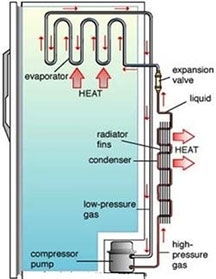How does a refrigerator work?
A refrigerator is a cabinet used for keeping food and other substances cool and fresh. It has solved the problem of storing food for short periods, particularly in hot climates. The freezing compartment can store foods for months together.
 The
working principle of a domestic refrigerator is shown in the figure. It is a compression and absorption refrigerator. Compression-and-absorption systems cool by changing a refrigerant from a liquid state to a gaseous state and back to the liquid state again.
The
working principle of a domestic refrigerator is shown in the figure. It is a compression and absorption refrigerator. Compression-and-absorption systems cool by changing a refrigerant from a liquid state to a gaseous state and back to the liquid state again.It consists of a storage tank, filled with Freon gas, the refrigerant control device, the evaporator, the compressor and the condenser. When the machine is switched on, Freon gas leaves the storage tank under high pressure. It travels through pipes of the refrigerant control device. These pipes act as an evaporator. The liquid Freon absorbs heat from the pipes and gets evaporated. As the heat is drawn out, the temperature inside the cabinet and that of the food materials falls. Freon gas is now again converted into liquid by the condenser and the compressor. This cycle continues and the temperature inside the cabinet goes on falling. When the temperature inside the cabinet reaches an optimum value, a thermostat control cuts off the electric power and the machine stops. Again the temperature starts rising. When it reaches a certain mark, thermostat control again starts the machine. In this way, a constant temperature is maintained and the food materials are preserved.
Home refrigerators are sealed, airtight, leak proof, heavily insulated cabinets that maintain cooling temperatures between 0 and 4°C. Most of them have freezing compartments that can maintain temperatures between -18°C and -14°C. Either electricity or gas may be used to power refrigerators.